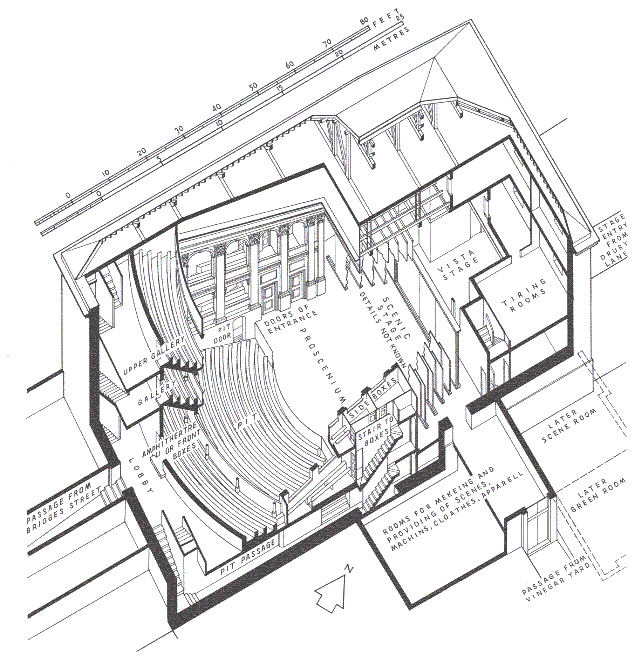"Our will and pleasure is that you prepare a Bill for our signature to passe our Great Seale of England, containing a Grant unto our trusty and wll beloved Thomas Killegrew Esquire, one of the Grooms of our Bed-chamber and Sir William Davenant Knight, to give them full power and authoritie to erect Two Companys of Players consisting respectively of such persons as they shall chuse and apoint; and to purchase or build and erect at their charge as they shall thinke fitt Two Houses of Theatres."
(draft of a warrant, 19 July 1660, by William Davenant, in: Deborah Payne Fisk (ed.) The Cambridge Companion to English Restoration Theatre, Cambridge, 2000) (Complete Warrant)
At the time of The Beggar's Opera, theatre in London had been active for sixty-eight years. However, the preceding eighteen years of puritan restriction of the theatre, and the conditions of its restoration still had a strong shaping effect on the dramatic conditions of the London of 1728. Influenced by continental theatre, and the expectations of a king more familiar with French than English entertainments, the theatres created bt Killegrew and Davenant were not the simple, open-air playhouses of Elizabethan and Jacobean drama. The free and open field of theatres known in Shakespeare's time was gone, replaced by a royally-backed monopoly. Likewise, many English stage traditions that held sway in the sixteenth and early seventeenth century were radically altered or even abandoned (the first to be discarded being the playing of females by young boys). The plays themselves were influenced by the Neoclassical French model, adopting a five act structure.
In 1682, the Duke's Players (Davenant's troupe, led by his successor Thomas Betterton, absorbed the King's players (Killegrew's). For the next ten years, London had only one theatre company, until, in response to the takeover of the United Company by a lawyer, Christopher Rich, older actors formed a competing company. They operated under a license, as the United Company held both royal patents. It was his son, John Rich that would later agree to produce The Beggar's Opera.

Richard Leacroft, The Development of the English Playhouse, Eyre Methuen Ltd 1973, p.95.
A reconstruction of Drury Lane Theatre, 1674
The Restoration stage, physically, was a two-level stage, with a scenic level in the rear, and a forward stage, or proscenium extending forward. The audience was no longer seated on stage, as in earlier English plays. Seating consisted of the pit (floor seating immediately before the proscenium), boxes set to the side of and behind the pit (as shown in this painting, drawn from Act III The Beggar's Opera), and the galleries, which lined the back of the theatre. The boxes were the most expensive and well-regarded seating, and the galleries the cheapest and lowest-class. The curtain was used only to open and close the play, and changes in scene took place in full view of the audience. The scenic stage, behind the proscenium, is thought to have been used primarily as a method of entrance onto the proscenium; there is, however, some argument on this subject. Scenery consisted of backdrops, painted to give the illusion of depth through perspective. To advantage this, the stage was raked significantly, the probably origin of the terms "upstage" and "downstage." A great deal of further information may be found here.
The audience of the Restoration theatre was a mixed bag of aristocracy, bourgeoise, and the out-and-out poor. The audience, especially in the pit, was and was expected to be rowdy, loud, and potentially violent. The wildest seating area was the pit, where young gallants usually sat. Often, the action in the pit would draw more attention than the action onstage.
The theatrical history of The Beggar's Opera is a long one, as one might expect from a play that has been consistently in print and performed since its opening night in 1728. It has been revived consistently through the nineteenth and twentieth centuries, and has additionally spawned several adaptations, the most famous of which is of course Brecht's Die Dreigroschenoper (The Threepenny Opera). It has had several revivals as well, the most famous being the 1920's revival at the Hammersmith Theatre in London. The play has been both adapted for film and for BBC television, the first in 1953, the second in 1983. At the time of its production, however, there were serious doubts as to how it would be received. It was initially turned down by Colley Cibber (in charge of Drury Lane Theatre), and when it was accepted by John Rich (who ran the United Company), the company's leading actor (James Quin) turned down the role of Macheath.
The Beggar's Opera was first produced on January 29th, 1728, in Lincoln's Inn Fields' theatre, formerlyLisele's Tennis Court. The cast is listed in Life and Letters on page 80. It ran for sixty-two nights, and brought in a total profit of £5,351, of which Gay received £693 (Figures from Life and Letters, page 86). He sold the copyright (along with the copyright for Fables) for ninety guineas, and it was published on February 14, 1728.